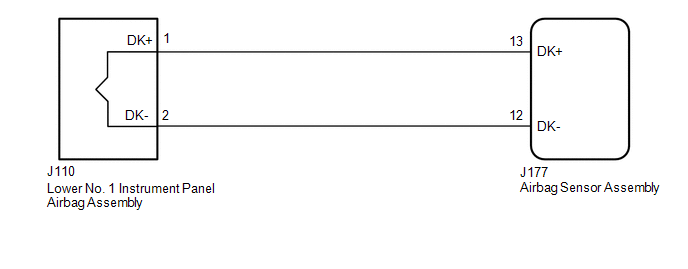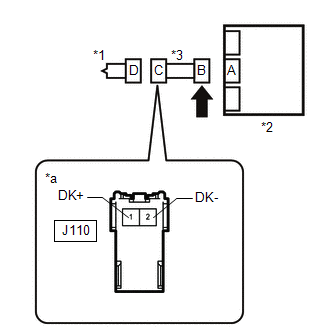DESCRIPTION The driver side knee squib circuit consists of the airbag sensor assembly and lower No. 1 instrument panel airbag assembly. This circuit instructs the SRS to deploy when deployment conditions are met. These DTCs are stored when a malfunction is detected in the driver side knee squib circuit.
WIRING DIAGRAM 
CAUTION / NOTICE / HINT NOTICE:
HINT: To perform the simulation method, enter check mode (signal check) with the Techstream
(Click here PROCEDURE
(b) Disconnect the cable from the negative (-) battery terminal, and wait for at least 90 seconds. (c) Check that the connectors are properly connected to the lower No. 1 instrument panel airbag assembly and airbag sensor assembly. OK: The connectors are properly connected. HINT: If the connectors are not properly connected, reconnect the connectors and proceed to the next inspection. (d) Disconnect the connectors from the lower No. 1 instrument panel airbag assembly and airbag sensor assembly. (e) Check that the terminals of the connectors are not deformed or damaged. OK: The terminals are not deformed or damaged. (f) Check that the instrument panel wire connector (on the lower No. 1 instrument panel airbag assembly side) is not loose, deformed or damaged. OK: The connector locking button is not disengaged, and the claw of the lock is not deformed or damaged. (g) Check that the short springs of the activation prevention mechanism of the instrument panel wire connector are not deformed or damaged. OK: The short springs are not deformed or damaged.
(b) Connect the white wire side of SST (resistance: 2.1 Ω) to connector C. CAUTION: Never connect the tester to the lower No. 1 instrument panel airbag assembly for measurement, as this may lead to a serious injury due to airbag deployment. NOTICE:
SST: 09843-18061 (c) Connect the cable to the negative (-) battery terminal, and wait for at least 2 seconds. (d) Turn the ignition switch to ON, and wait for at least 60 seconds. (e) Clear the DTCs. Click here (f) Turn the ignition switch off. (g) Turn the ignition switch to ON, and wait for at least 60 seconds. (h) Check for DTCs. Click here
HINT: Codes other than DTC B1860, B1861, B1862 and B1863 may be output at this time, but they are not related to this check. (i) Turn the ignition switch off. (j) Disconnect the cable from the negative (-) battery terminal, and wait for at least 90 seconds. (k) Disconnect SST from connector C.
(a) Disconnect the instrument panel wire from the airbag sensor assembly. 
(b) Check for a short to B+ in the circuit. (1) Connect the cable to the negative (-) battery terminal, and wait for at least 2 seconds. (2) Turn the ignition switch to ON. (3) Measure the voltage according to the value(s) in the table below. Standard Voltage:
(4) Turn the ignition switch off. (5) Disconnect the cable from the negative (-) battery terminal, and wait for at least 90 seconds. (c) Check for an open in the circuit. (1) Measure the resistance according to the value(s) in the table below. Standard Resistance:
(d) Check for a short to ground in the circuit. (1) Measure the resistance according to the value(s) in the table below. Standard Resistance:
(e) Check for a short in the circuit. (1) Release the activation prevention mechanism built into connector B. Click here (2) Measure the resistance according to the value(s) in the table below. Standard Resistance:
(3) Restore the released activation prevention mechanism of connector B to the original condition.
(b) Connect the cable to the negative (-) battery terminal, and wait for at least 2 seconds. (c) Turn the ignition switch to ON, and wait for at least 60 seconds. (d) Clear the DTCs. Click here (e) Turn the ignition switch off. (f) Turn the ignition switch to ON, and wait for at least 60 seconds. (g) Check for DTCs. Click here
HINT: Codes other than DTC B1860, B1861, B1862 and B1863 may be output at this time, but they are not related to this check.
|
Toyota Tundra Service Manual > Occupant Classification System: Rear Occupant Classification Sensor LH Collision Detection (B1787)
DESCRIPTION DTC B1787 is set when the occupant classification ECU receives a collision detection signal, which is sent by the rear occupant detection sensor LH when an accident occurs. DTC B1787 is also set when the front seat frame with adjuster RH is subjected to a strong impact, even if an actual ...